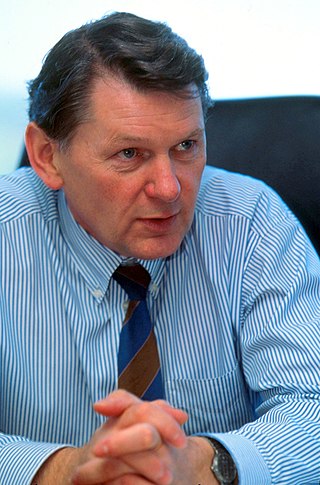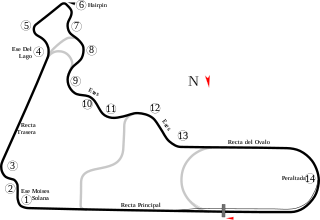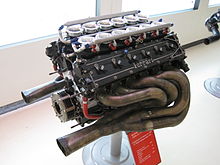
Gerhard Berger is an Austrian former Formula One racing driver. He competed in Formula One for 14 seasons, twice finishing 3rd overall in the championship, both times driving for Ferrari. He won ten Grands Prix, achieved 48 podiums, 12 poles and 21 fastest laps. With 210 starts he is amongst the most experienced Formula One drivers of all time. He led 33 of the 210 races he competed in and retired from 95 of them. His first and last victories were also the first and last victories for the Benetton team, with eleven years separating them. He was also a race winner with Ferrari and with McLaren. When at McLaren, Berger drove alongside Ayrton Senna, contributing to the team's 1990 and 1991 constructors' titles.

John Edward Barnard, is an English engineer and racing car designer. Barnard is credited with the introduction of two new designs into Formula One: the carbon fibre composite chassis first seen in 1981 with McLaren, and the semi-automatic gearbox which he introduced with Ferrari in 1989.

The 1986 Italian Grand Prix was a Formula One motor race held at Monza on 7 September 1986. It was the thirteenth race of the 1986 Formula One World Championship.

The 1989 Brazilian Grand Prix was a Formula One motor race held at Jacarepaguá, Rio de Janeiro on 26 March 1989. It was the first race of the 1989 Formula One World Championship.

The 1989 Mexican Grand Prix was a Formula One motor race held at the Autódromo Hermanos Rodríguez, Mexico City on 28 May 1989. The race, contested over 69 laps, was the fourth race of the 1989 Formula One season and was won from pole position by Ayrton Senna, driving a McLaren-Honda, with Riccardo Patrese second in a Williams-Renault and Michele Alboreto third in a Tyrrell-Ford.

The 1989 German Grand Prix was a Formula One motor race held at the Hockenheimring on 30 July 1989. The race was won by Ayrton Senna, ahead of Alain Prost and Nigel Mansell.

The 1989 Italian Grand Prix was a Formula One motor race held at Monza on 10 September 1989. It was the twelfth race of the 1989 Formula One season.

The 1989 Portuguese Grand Prix was a Formula One motor race held at the Autódromo do Estoril in Estoril, Portugal on 24 September 1989. It was the thirteenth race of the 1989 Formula One World Championship.

The 1989 Spanish Grand Prix was a Formula One motor race held at Jerez on 1 October 1989. It was the fourteenth race of the 1989 Formula One World Championship.
The 1992 Canadian Grand Prix was a Formula One motor race held at Circuit Gilles Villeneuve, Montreal on 14 June 1992. It was the seventh race of the 1992 Formula One World Championship.

The 1991 FIA Formula One World Championship was the 45th season of FIA Formula One motor racing and the 42nd season of the Formula One World Championship. It featured the 1991 Formula One World Championship for Drivers and the 1991 Formula One World Championship for Constructors, which were contested concurrently over a sixteen-race series that commenced on 10 March and ended on 3 November. Ayrton Senna won his third and last Drivers' Championship, and McLaren-Honda won their fourth consecutive Constructors' Championship. Senna won seven of the sixteen races; his main challenger for the title was Nigel Mansell, who won five races in his first season back at Williams. Senna's fierce rival Alain Prost failed to win a race with Ferrari and was fired before the end of the season due to a dispute with the team. 1991 also saw the debuts of future world champions Michael Schumacher and Mika Häkkinen, as well as the retirement of three-time champion Nelson Piquet.

The 1990 FIA Formula One World Championship was the 44th season of FIA Formula One motor racing. It featured the 1990 Formula One World Championship for Drivers and the 1990 Formula One World Championship for Constructors, which were contested concurrently over a sixteen-race series that commenced on 11 March and ended on 4 November. Ayrton Senna won in controversial circumstances the Drivers' Championship for the second time, and McLaren-Honda won their third consecutive Constructors' Championship.

The 1989 FIA Formula One World Championship was the 43rd season of FIA Formula One motor racing. It began on 26 March and ended on 5 November. Alain Prost won his third Drivers' Championship, and McLaren won the Constructors' Championship.

The 1988 FIA Formula One World Championship was the 42nd season of FIA Formula One motor racing. It featured the 1988 Formula One World Championship for Drivers and the 1988 Formula One World Championship for Constructors, which were contested concurrently over a sixteen-race series that commenced on 3 April and ended on 13 November. The World Championship for Drivers was won by Ayrton Senna, and the World Championship for Constructors by McLaren-Honda. Senna and McLaren teammate Alain Prost won fifteen of the sixteen races between them; the only race neither driver won was the Italian Grand Prix, where Ferrari's Gerhard Berger took an emotional victory four weeks after the death of team founder Enzo Ferrari. McLaren's win tally has only been bettered or equalled in seasons with more than sixteen races; their Constructors' Championship tally of 199 points, more than three times that of any other constructor, was also a record until 2002.

The 1986 FIA Formula One World Championship was the 40th season of FIA Formula One motor racing. It featured the 1986 Formula One World Championship for Drivers and the 1986 Formula One World Championship for Manufacturers, both of which commenced on 23 March and ended on 26 October after sixteen races. The Drivers' Championship was won by Alain Prost, and the Manufacturers' Championship was won by Williams-Honda, thus Honda became the first Japanese engine supplier World Champions of Formula One, and adding a constructors' title to Frank Williams' trophy collection. Prost was the first driver to win back-to-back Drivers' Championships since Jack Brabham in 1959 and 1960.

The McLaren MP4/6 is a successful Formula One racing car designed by McLaren's Neil Oatley, Matthew Jeffreys, David North, David Neilson, Bob Bell and Mike Gascoyne; powered by the Honda RA121E V12 engine for use in the 1991 Formula One season, with the engine's design and development led by Osamu Goto. It was driven by reigning World Champion, Brazilian Ayrton Senna, and Austria's Gerhard Berger. Ayrton Senna would win his third World Championship in the MP4/6. The MP4/6 was notable for being the last F1 car to win the championship with a manual gearbox and the only F1 car powered by a V12 engine to do so.

The McLaren MP4/5, and its derived sister model, the McLaren MP4/5B, were highly successful Formula One racing cars designed by the McLaren Formula One team based in Woking, England, and powered by Honda's naturally-aspirated RA109E and RA100E V10 engines respectively. The chassis design was led by Neil Oatley, teaming up with Steve Nichols, Pete Weismann, Tim Wright, Bob Bell and Mike Gascoyne. As with the previous designs, Gordon Murray, as Technical Director, had the role of liaising between the drawing office and production. Osamu Goto was the Honda F1 team chief designer for the car's engine.

The Ferrari 641 was the Formula One racing car with which the Ferrari team competed in the 1990 Formula One World Championship. Driven by Alain Prost and Nigel Mansell, it won six Grands Prix.

The Ferrari F1/87 is a Formula One racing car used by the Ferrari team during the 1987 Formula One season. The car was driven by Michele Alboreto and Gerhard Berger and replaced the Ferrari F1/86 used in 1986.

The Benetton B190 is a Formula One racing car designed by Rory Byrne in collaboration with Benetton's Technical Director, John Barnard, a designer with experience at racing companies McLaren and Ferrari and arguably the most successful Formula One designer of the 1980s with his cars winning 31 races since 1981. Geoff Goddard, chief designer at Cosworth was responsible for designing the car's engine, which was of exclusive use for Benetton. The B190 was raced by Benetton in all but the first two races of the 1990 Formula One season.



















